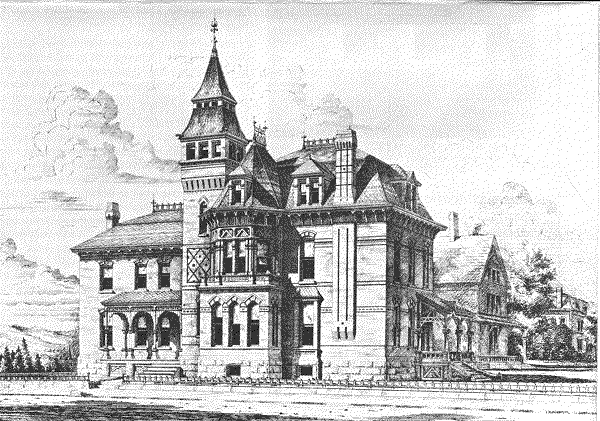James Street |
|||
|
Postcard of James Street, about 1900
Lower James Street was once the most exclusive residential area in Syracuse. The authors of Architecture Worth Saving say that, at its peak, James Street was, "one of the most handsome residential streets in the State of New York. Its houses, ranging in date from the 1830's to the 1890's, were not only fine in themselves but they constituted a beautiful ensemble." Moses Dewitt Burnet probably initiated the mansion competition with an imposing Greek Revival home completed in 1842. Each subsequent home builder strove to establish their prominence in the city by creating something grander than those that had come before. John Wilkinson had a house surrounded by extensive grounds and gardens at the corner of James and Hawley Avenue. General Leavenworth and his family built their majestic Greek Revival home at the corner of James and McBride.
In 1950, The Leavenworth Mansion was the first of the grand homes to be demolished. The Gilded Age had ended long ago and few could now afford to maintain these enormous homes. On West Genesee, across town, the tree lined street with it graceful homes was being systematically converted into an auto dealer row. Rather than see the character of James changed in this way, the city decided to destroy James to save it. The city fathers welcomed developers who would replace the vacant mansions with new high-rise apartment buildings and office complexes. The James Street mansions would be lost, but wasn't that better than seeing them converted into used car dealerships? By the early 1960's the grand homes were nearly gone. As AWS puts it, "James Street has as little character today as the average street from Long Island to Los Angeles." The loss was not inevitable. The grand homes of South Main Street in Geneva, New York were preserved through the efforts of its residents. In Rochester, East Avenue was once the most exclusive residential area. When homes there started to disappear in the early 1950's the city took action to prevent further loss. Most of the original East Avenue homes have survived to this day. |
|||
|
On James John D. Norton House The Neal House Moses Burnet House The Day House Kenyon Residence White Residence Kempster Residence Barnes-Hiscock Residence Edwards Residence Holden Residence W. E. Kane Residence Lynch Residence Dey's Residence Burns Lyman Smith Residence Wilkinson Residence |
Off James
Seubert Residence
Garrett Residence
Coburn Residence
Russell Hebbard House
Apartment Building
|
||

